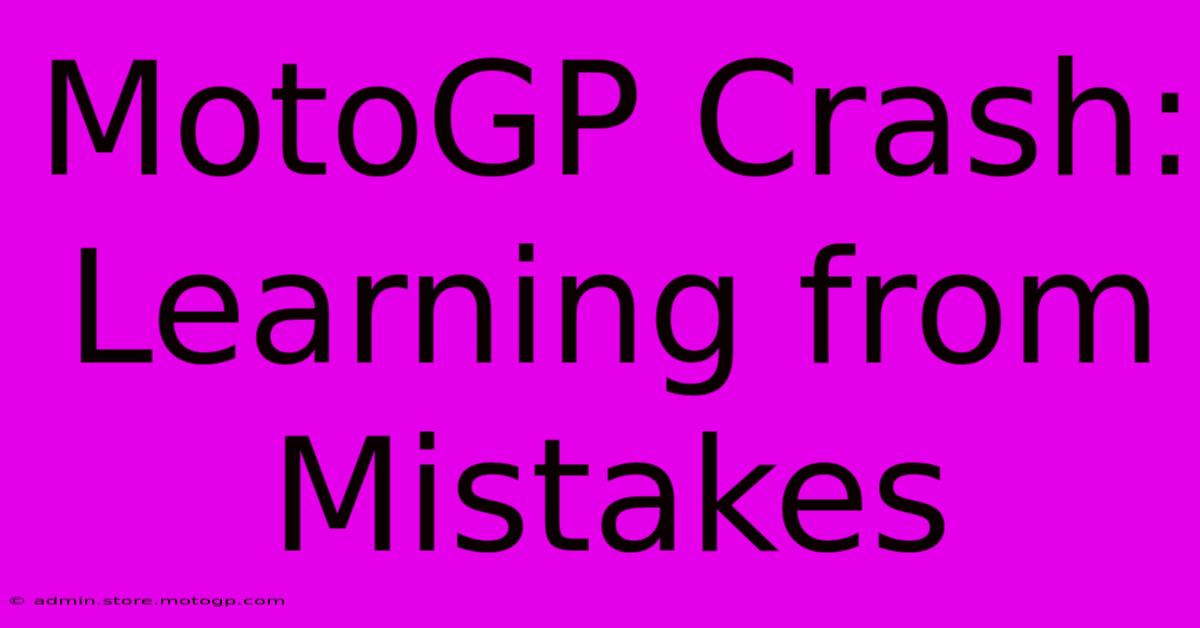MotoGP Crash: Learning From Mistakes

Table of Contents
MotoGP Crash: Learning from Mistakes
MotoGP, the pinnacle of motorcycle racing, is a breathtaking spectacle of speed, skill, and precision. But behind the adrenaline-fueled races and stunning overtakes lies a harsh reality: crashes. These crashes, sometimes minor, sometimes devastating, are an unavoidable part of the sport. However, they offer invaluable lessons – not just for the riders themselves, but for the teams, engineers, and even the sport's governing body. This article delves into the analysis of MotoGP crashes, exploring how mistakes are identified, corrected, and ultimately, used to improve safety and performance.
Understanding the Causes of MotoGP Crashes
MotoGP crashes are rarely caused by a single factor. Instead, they typically result from a complex interplay of various elements:
Rider Error:
- Pushing the Limits: The inherent nature of MotoGP involves riders constantly pushing the boundaries of speed and control. A small mistake, a momentary lapse in concentration, can be amplified at these incredible speeds, leading to a crash.
- Loss of Traction: Losing grip, whether on the front or rear tire, is a primary cause of crashes. This can be due to factors like track conditions (wet or oily patches), tire wear, or aggressive riding style.
- Incorrect Line Choice: Choosing the wrong racing line, particularly in high-speed corners, can quickly escalate into a loss of control and a fall.
- Mechanical Failure: While less frequent, mechanical failures such as brake issues, engine problems, or suspension malfunctions can cause riders to lose control.
External Factors:
- Track Conditions: Rain, oil spills, debris on the track, and even changes in track temperature can dramatically affect grip and handling, increasing the risk of crashes.
- Other Riders: Collisions with other riders, often due to aggressive overtaking maneuvers or racing incidents, are a significant cause of crashes, impacting multiple riders at once.
- Track Design: While less common, specific track characteristics might contribute to accidents, leading to calls for modifications or improvements in safety measures.
Analyzing and Learning from Crashes
After a crash, a rigorous process of investigation and analysis is undertaken to determine the root cause. This involves:
Data Acquisition:
- Telemetry Data: Sophisticated sensors on the bikes record vast amounts of data during a race, including speed, lean angle, throttle position, braking force, and more. This data allows engineers to reconstruct the crash and identify critical moments leading to the fall.
- Onboard Camera Footage: Onboard cameras provide a rider's perspective of the crash, giving valuable visual insight into the events leading to the incident.
- Post-Crash Examination: The motorcycle itself undergoes a thorough examination to detect any mechanical failures or anomalies that might have contributed to the crash.
Identifying the Root Cause:
By combining data analysis, video footage, and physical inspection, experts can pinpoint the contributing factors to the crash, whether it's a rider error, mechanical fault, or external influence.
Preventing Future Crashes
Once the cause of a crash is identified, steps are taken to prevent similar incidents in the future. These measures can include:
- Rider Training: Crash analysis provides valuable feedback for rider training programs, helping riders understand and avoid risky situations.
- Technological Advancements: Improved tire technology, enhanced electronic rider aids (such as traction control and anti-lock brakes), and safer bike designs all play a crucial role in preventing crashes.
- Track Improvements: Modifying track layouts, improving safety barriers, and upgrading track surfaces contribute to enhanced safety.
- Regulation Changes: The governing body, Dorna Sports, may implement rule changes or safety regulations based on the analysis of crashes, striving for a safer and more competitive racing environment.
Conclusion:
MotoGP crashes, while inherently dramatic and sometimes dangerous, are integral to the sport's continuous evolution. The meticulous analysis of these incidents, coupled with a commitment to learning from mistakes, drives improvements in rider training, motorcycle technology, track safety, and overall racing regulations. This constant cycle of analysis and improvement ensures that MotoGP remains at the forefront of motorsport, pushing the boundaries of speed and technology while striving to maintain the highest levels of safety.

Thank you for visiting our website wich cover about MotoGP Crash: Learning From Mistakes. We hope the information provided has been useful to you. Feel free to contact us if you have any questions or need further assistance. See you next time and dont miss to bookmark.
Featured Posts
-
Moto 3 Bikes The Ultimate Lightweight Racing Adventure
Feb 19, 2025
-
The Best Motorcyclist Ever A Story Of Triumph
Feb 19, 2025
-
Moto Gp Top Speed Breaking Barriers
Feb 19, 2025
-
Cota Lot A Your Dream Home Starts Here
Feb 19, 2025
-
Elevate Your Skills Cota Motorcycle Track Days Await
Feb 19, 2025
